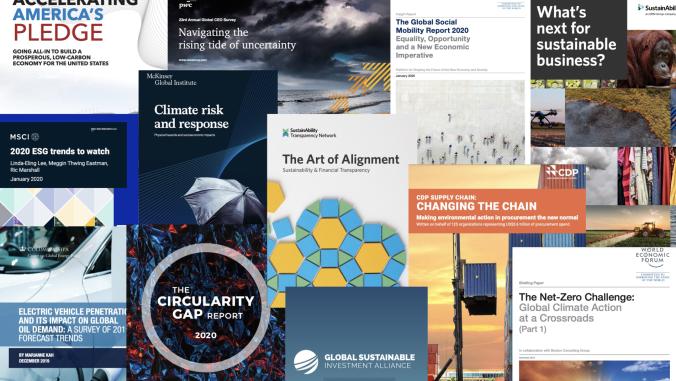On mobility, purpose, partnerships, SDGs and more
Your monthly round up of what to know now about top reports in sustainable business and clean technology.

The Report Report is a monthly wrap-up of recent research on sustainable business and clean technology, produced by Corporate Eco Forum, a by-invitation membership organization comprised of large, global companies that demonstrate a serious commitment at the senior executive level to sustainability as a business strategy issue.
"2 Degrees of Separation — Transition Risk for Oil and Gas in a Low-Carbon World" (Carbon Tracker) ranks 69 oil and gas companies according to the financial impact the low carbon transition will have on their business (under a business-as-usual scenario). The report finds that these companies plan to invest $2.3 trillion — roughly a third of business-as-usual investment to 2025 — into uneconomic projects that are not aligned with the low carbon transition. The report also finds that ExxonMobil is the most exposed oil and gas company, with as much as 50 percent of its capital expenditures allocated to uneconomic projects.
"How Can Purpose Reveal a Path Through Disruption? Mapping the Journey from Rhetoric to Reality" (PDF) (EY) finds that 84 percent of executives surveyed classified the environment in which their companies are operating within as volatile, uncertain, complex and ambiguous. As a result, 66 percent are "profoundly rethinking" their company’s purpose and the value it provides to stakeholders in the short term and down the line; 73 percent believe that having a well-integrated purpose enables companies to navigate uncertainty and disruption more effectively.
"The Future(s) of Mobility: How Cities Can Benefit" (McKinsey & Co.) finds that integrated mobility systems could deliver up to $600 billion in benefits — such as improved safety and less pollution — for 50 metropolitan cities worldwide by 2030. The report also highlights trends that are expected to have a significant impact on the development of integrated mobility in cities: shared mobility; autonomous vehicles; electric vehicles; the Internet of Things; public transit; infrastructure; decentralized energy systems; and regulation.
"Corporate Sustainability at a Crossroads: Progress Toward Our Common Future in Uncertain Times" (MIT Sloan Management Review and the Boston Consulting Group) presents the findings of an eight-year corporate sustainability research effort based on survey responses from more than 60,000 business practitioners at global companies and more than 150 thought-leader interviews. Just a few key findings include:
- Companies that focus on material issues reported up to 50 percent added profit from sustainability activities, compared to those that do not.
- 90 percent of executives surveyed believe sustainability is important. However, 60 percent of companies have a sustainability strategy, and only 25 percent have developed a clear business case for their sustainability efforts.
- Building sustainability into business units can double an organization’s chance of profiting from its sustainability activities.
- Collaboration is viewed as essential to sustainability success by 90 percent of executives surveyed. However, only 47 percent say their companies collaborate strategically.
"Global Impacts Report 2017" (PDF) (Marine Stewardship Council) examines the history of the MSC and the positive impact its certification has had on fish stocks and marine habitats worldwide over the past 20 years. The report finds that 296 fisheries in 35 countries are MSC-certified as sustainable, representing 12 percent of global wild catch.
"Renewables 2017 Global Status Report" (REN21) finds that a record 161 gigawatts (GW) of renewable energy capacity was added globally in 2016 — up 9 percent from 2015 levels. Just a few key findings included:
- Investment in new renewable power capacity reached $250 billion in 2016 — roughly double the investment in fossil fuel generating capacity.
- Solar photovoltaic (PV) accounted for around 47 percent of total renewable energy capacity additions in 2016, followed by wind power (34 percent) and hydropower (15.5 percent).
- Record-breaking tenders for solar PV occurred in Argentina, Chile, India, Jordan, Saudi Arabia and the United Arab Emirates in 2016, and record low bids for wind power occurred in several countries, including Chile, India, Mexico and Morocco.
"Better Business, Better World Asia" (Business & Sustainable Development Commission) finds that sustainable business models could unlock $5 trillion in economic benefits through new market opportunities and generate 230 million jobs in Asia by 2030. The report finds that energy and minerals present the biggest economic opportunity ($1.9 trillion), followed by cities ($1.5 trillion), food & agriculture ($1 trillion), and health and wellbeing ($670 billion).
"Progress Towards the Sustainable Development Goals" (United Nations) provides a snapshot of global progress against the 17 Sustainable Development Goals (SDGs) using the latest available data. The report finds that the global poverty rate has dropped 50 percent since 2000 (SDG No. 1), over 90 percent of the world’s population used improved drinking water sources and over 66 percent of the world’s population used improved sanitation facilities in 2015 (SDG No. 6). Despite good progress in these areas, the report finds that significant action is still needed to achieve the SDGs.
"Battery Storage: The Next Disruptive Technology in the Power Sector" (McKinsey & Co.) offers insight into the energy storage state of play, with an emphasis on new market opportunities for utilities and individual customers.
"Driving Growth and Innovation through Supplier Partnerships" (PDF) (3M) analyzes survey responses from 237 suppliers based in the U.S. to identify trends, challenges and opportunities across the supply chain (not specific to 3M). The analysis finds that positive business outcomes are driving over three-quarters of suppliers to operate more sustainably. The analysis also finds that volatile commodity and supply prices is the greatest risk facing suppliers today.





